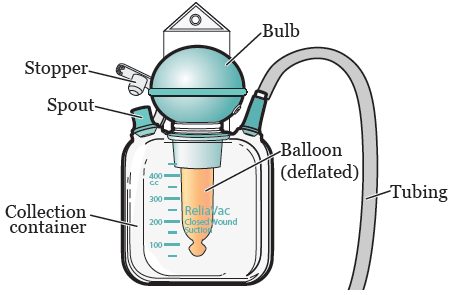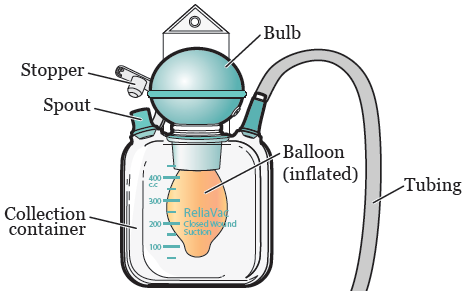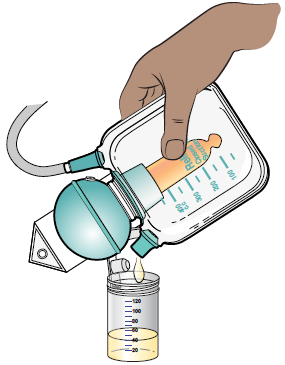This information explains how to care for your ReliaVac® (rel-eye-uh-vak) drain.
About Your ReliaVac Drain
You have a ReliaVac drain to drain the fluid that collects under your incision (surgical cut) after your surgery. The amount of fluid that drains (called drainage) is different for everyone. Some people have a lot of drainage after surgery, while others only drain a little. You may have more than 1 drain in place.
The length of time that you will have your ReliaVac drain depends on your surgery. It also depends on the amount of fluid that is draining. Your drain will be taken out when your drainage over a 24-hour period is less than 30 milliliters (mL). That is 1 ounce. If you have more than 1 drain, the total amount for all drains must be less than 30 mL in 24 hours.
To track your drainage, you will write down the amount in a drainage log. You can find the log in the print version of this resource. It’s important to bring the log with you to your follow-up appointments.
Parts of Your ReliaVac Drain
Your ReliaVac drain is a clear plastic collection container with a balloon inside (see Figure 1). It’s attached to a tube with a Y-shaped connector at the end. The other side of the Y-shaped connector is attached to a catheter (thin tube), which is placed near your incision.

When the balloon inside the collection container is inflated (filled up), it creates a constant, gentle suction (see Figure 2). This suction helps pull out the fluid that collects under your incision. The balloon should always be inflated except when you’re emptying your drainage, unless your healthcare provider told you otherwise.

Caring for Your ReliaVac Drain at Home
Your nurse will work with you until you’re able to care for your ReliaVac drain on your own. They will watch you the first time you empty your drainage to make sure you’re doing it right. Even after you start to care for your drain by yourself, we are always here to help. If you have any problems with your drain, call your healthcare provider.
To care for your ReliaVac drain at home, you will need to:
- Milk the tubing. This will help remove clots that build up in the tubing and make sure that the fluid flows correctly. For more information, read the “Milking the tubing” section.
- Empty the collection container at least 2 times a day. Empty it in the morning and in the evening. You must write down in your drainage log the total amount of drainage for every 24-hour period. Remember to call your healthcare provider to tell them the amount you collected in a 24-hour period. For more information, read the “Emptying your ReliaVac drain and writing down the drainage amount” section.
- Care for your drain insertion site. This is the area where the catheter enters your skin. For more information, read the “About Your Drain Insertion Site” section.
- Make sure your ReliaVac drain is pinned securely below your insertion site at all times. Make sure there are no kinks in the tubing. For more information, read the “Problems You May Have With Your Drain” section.
- Notice when there is a problem and call your healthcare provider. For more information, read the “Problems You May Have With Your Drain” section.
Milking the tubing
Sometimes a blockage in the tubing can slow your drainage flow or stop it suddenly. This is usually caused by clots that build up in the tubing. These clots may look like strings. To get rid of these clots, you will need to milk the tubing. Make sure to milk the tubing before you empty and measure your drainage. You will need to do this more often if your drainage flow is slow or stops suddenly.
To milk the tubing, follow these steps:
- Clean your hands.
- If you’re washing your hands with soap and water, wet your hands with warm water and apply soap. Rub your hands together for at least 20 seconds, then rinse. Dry your hands with a paper towel. Use that same towel to turn off the faucet.
- If you’re using an alcohol-based hand sanitizer, be sure to cover all parts of your hands with it. Rub your hands together until they are dry.
- Look at the tubing while standing in front of a mirror. This will help you see where your hands need to be.
- Pick a point close to your drain insertion site. This is the area where the catheter enters your skin. Pinch and hold the tubing with your thumb and index (pointer) finger. This will help prevent tugging at the insertion site.
- With the thumb and index finger of your other hand, pinch the tubing right below your other fingers. Keep your fingers pinched as you slide them down the entire length of the tubing. This will push any clots into the collection container. You may use alcohol pads your nurse gave you to help slide your fingers down the length of the tubing.
- Repeat steps 3 and 4 as needed to remove all clots from the tubing. Do this until you see the fluid move down the tubing and into the collection container. If you cannot move a clot into the container and your drain has stopped draining, call your healthcare provider.
Emptying your ReliaVac drain and writing down the drainage amount

You need to empty your collection container at least 2 times a day. Empty it in the morning and evening. You may need to empty it more often if you have a large amount of drainage in your container.
To empty your collection container, follow these steps:
- Gather your supplies.
- The measuring container your nurse gave to you.
- Your drainage log.
- Pen or pencil.
- Clean your hands.
- If you’re washing your hands with soap and water, wet your hands with warm water and apply soap. Rub your hands together for at least 20 seconds, then rinse. Dry your hands with a paper towel. Use that same towel to turn off the faucet.
- If you’re using an alcohol-based hand sanitizer, be sure to cover all parts of your hands with it. Rub your hands together until they are dry.
- Unplug the stopper on top of your ReliaVac drain (see Figure 1). This will cause the balloon inside the collection container to deflate (get smaller). Do not touch the inside of the stopper or the inner area of the drainage spout.
- Pour the drainage from your collection container into the measuring container (see Figure 3).
- Turn your ReliaVac drain right side up.
- Pump the bulb at the top of the drain until the balloon is fully inflated (fills up the whole container).
- Continue to pump the bulb while you plug the stopper. After plugging the stopper, you will hear a hissing sound. This is normal and will stop after a few seconds.
- Check to see that the balloon stays fully inflated. This will keep the gentle suction working so it can pull out the fluid that collects under your incision.
- Pin the collar of your drain to your clothing. Don’t let it dangle, hang loose, or swing around. You can wear a fanny pack or belt bag to help hold the drain in place.
- Check the amount of drainage in the measuring cup. Write this amount down in your drainage log. If you have more than 1 drain, measure and write down the amount in each one.
- Empty your drainage in the toilet and rinse the measuring cup with water.
- At the end of each day, add up the total amount of your drainage for the 24-hour period. Write this amount down in your drainage log in the “Total” column.
About Your Drain Insertion Site
Once you have emptied your drainage, wash your hands again. Check the area around your drain insertion site. This is the area where the catheter enters your skin. Your insertion site may be covered with a dressing or bandage to protect it from getting infected. Your healthcare provider will give you instructions about dressings, if needed.
It’s normal for your ReliaVac drain to cause some redness at your insertion or suture (stitches) site. Call your healthcare provider right away if you have any signs of infection. Some signs of infection are:
- A fever of 101° F (38.3° C) or higher.
- Tenderness or pain around your insertion site that is getting worse.
- Swelling, heat, or pus coming from your insertion site.
- Bad odor (smell) coming from your insertion site or from the fluid that is draining.
Problems You May Have With Your ReliaVac Drain
| Problems You May Have With Your ReliaVac Drain | |
|---|---|
Problem
|
Reason
What to do
|
Problem
|
Reason
What to do
|
Problem
|
Reason
What to do
|
Problem
|
Reason
What to do
|
Call your healthcare provider right away if:
- Your drainage becomes bright red in color.
- You notice a sudden increase in the amount of your drainage.
- You have a fever of 101° F (38.3° C) or higher.
- These side effects at your drain insertion site have gotten worse:
- Redness
- Tenderness
- Swelling
- Pus
- Bad odor (smell)
Call your healthcare provider during business hours if:
- The amount of your drainage goes up or down by 100 mL in a 24-hour period.
- Your tubing falls out.
- You cannot inflate the balloon inside your collection container.
- You cannot milk the tubing (move a clot from the tubing into the collection container). If this happens on a weekend or holiday, call the next business day.
If you have any questions, contact a member of your care team directly Monday through Friday from to If you’re a patient at MSK and you need to reach a healthcare provider after , during the weekend, or on a holiday, call 212-639-2000.
Drainage Log
ReliaVac® Drainage Log RV# _________
Date |
Morning |
Evening |
Total |
Comments |
|---|---|---|---|---|
|
|
|
|
|
|
|
|
|
|
|
|
|
|
|
|
|
|
|
|
|
|
|
|
|
|
|
|
|
|
|
|
|
|
|
|
|
|
|
|
|
|
|
|
|
|
|
|
|
|
|
|
|
|
|
|
|
|
|
|
|
|
|
|
|
|
|
|
|
|
|
|
|
|
|
|
|
|
|
|
|
|
|
|
|
|
|
|
|
|
|
|
|
|
|
|
|
|
|
|
|
|
|
|
|
|
|
|
|
|
|
|
|
|
|
|
|
|
|
|
ReliaVac® Drainage Log RV# _________
Date |
Morning |
Evening |
Total |
Comments |
|---|---|---|---|---|
|
|
|
|
|
|
|
|
|
|
|
|
|
|
|
|
|
|
|
|
|
|
|
|
|
|
|
|
|
|
|
|
|
|
|
|
|
|
|
|
|
|
|
|
|
|
|
|
|
|
|
|
|
|
|
|
|
|
|
|
|
|
|
|
|
|
|
|
|
|
|
|
|
|
|
|
|
|
|
|
|
|
|
|
|
|
|
|
|
|
|
|
|
|
|
|
|
|
|
|
|
|
|
|
|
|
|
|
|
|
|
|
|
|
|
|
|
|
|
|